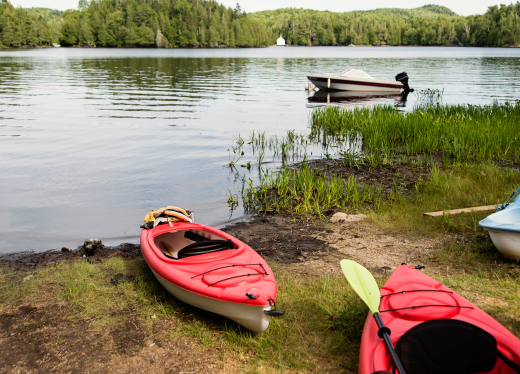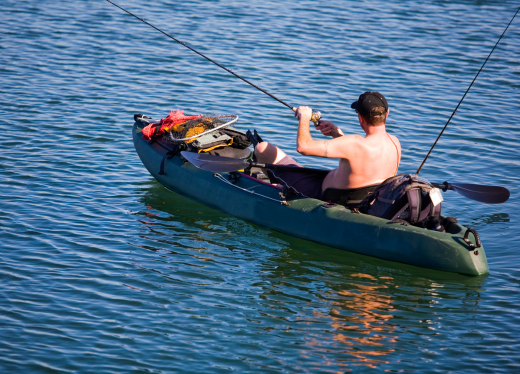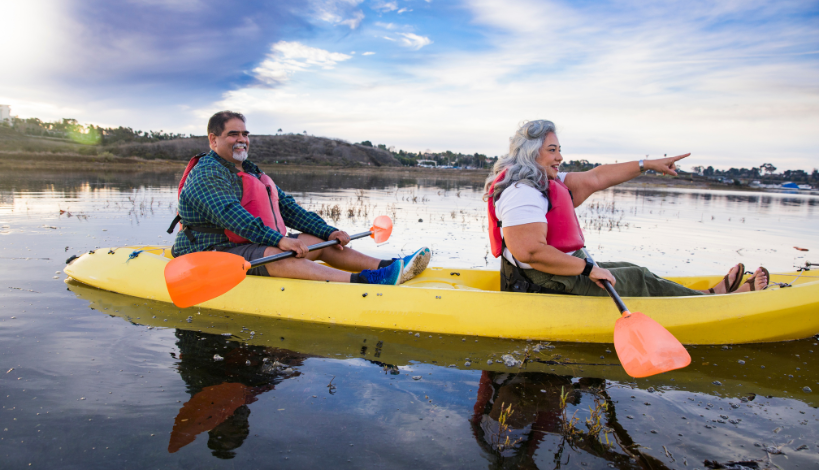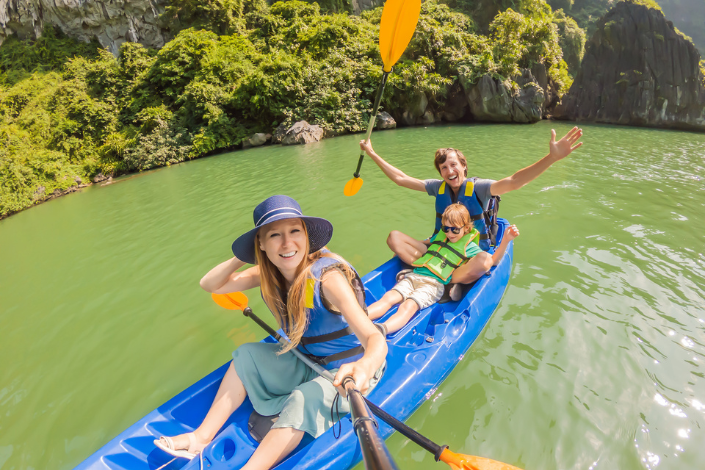Choosing the right size kayak is essential for a comfortable and enjoyable paddling experience. The type of kayaking that you plan on doing will determine what size boat you need. Kayaks come in different sizes, from small recreational models to large touring ones.
Before you make your purchase, it’s important to understand which size kayak will be best suited for your activity and body type. I’ve made the mistake of buying a kayak without realizing that I needed a lot more room for the activities I wanted to have fun with and as a result, I ended up selling it within a few months. Don’t make the mistake I did!
What Size Kayak Should You Get?

Before you make up your mind on what kayak you should get, there are a few things you need to consider to figure out what size will work for you.
Let’s chat a bit more about your individual factors:
#1. Consider Your Weight, Height, And Experience Level
It’s important to know your height, weight, and experience level in order to choose the best sized kayak for you.
If you are just starting out paddling, it’s a good idea to purchase a sit-on-top or recreational kayak rather than a sit-in sea or touring kayak because recreational and sit-on-top kayaks are generally easier to get into and out of with less effort.
If you are more than 6 feet tall, you may want to look at longer boats which will provide extra leg room. On the other hand, if you’re shorter, then shorter boats with low decks might be more suitable.
The width of the boat can also make a difference in how stable it is on the water; wider boats are usually more stable, while narrower ones are faster but require more skill to control them. I personally prefer stable kayaks over faster one so consider that in choosing the size of your kayak.
Your weight is also an important factor when choosing the right size kayak. Heavier people will need larger and heavier kayaks that can hold their weight in rough waters, whereas lighter individuals may be fine with lighter models.
While most recreational boats can accommodate up to 250 pounds, for heavier users, it is advised that they look at specialty kayaks which can support their bodyweight without capsizing or feeling unbalanced in the water. Measure the cockpit and leg space to make sure you can fit in the kayak comfortably.
Finally, take into account your experience level as well when picking out the right size kayak for yourself. Beginners should look for short recreational models that are designed specifically for novice paddlers. More experienced users could possibly get away with longer designs made for speedier maneuvers in slightly rougher waters.
Making sure you pick out the proper sized boat based on your height, weight, and experience level will help ensure that your time spent on the water is enjoyable rather than uncomfortable and unsafe.
#2. Decide Where You’ll Be Kayaking

While there is no one-size-fits-all solution, determining which size kayak you’ll need could be more easily determined by how and where you plan to use it.
If you’re looking for a kayak to use for a relaxing day of fishing, then a longer, wider vessel may be the way to go. These models are designed with stability and storage space in mind, allowing you to bring along all your gear while staying steady on the water. This would be especially helpful for ocean fishing.
Those looking to tackle whitewater rapids or ocean swells should opt for sturdier models equipped with features such as extra floatation devices (flotation bags) that help the craft stay afloat in rougher conditions.
If you plan on taking multiple trips or need something that can transport more than one person at once, consider a tandem model that accommodates two or three paddlers.
If you plan on spending extended periods of time out on the water, opt for larger recreational models with more storage capacity and other amenities like rod holders and cupholders. These vessels are typically longer and wider than touring kayaks but are also perfect for camping trips or weekend getaways that require plenty of gear.
#3. Consider Storage Space And Accessories

I cannot preach this enough: when choosing the right kayak for your next adventure, storage space and accessories are two of the most important factors to consider!
For example, if you plan on taking along a lot of supplies such as camping gear or fishing equipment, then opting for a larger kayak with ample storage capacity is essential. Many larger models come with extra compartments, hatches, and cargo straps that make it easy to store away additional items without having to use up valuable real estate in the cockpit or bow.
The type of accessories you plan on bringing along will also determine what size kayak you should get. If you want to bring along specialized equipment such as rod holders, tackle boxes or camping supplies, then a model with multiple mounting points would be ideal.
However, if these items are not necessary for your trip, then a more basic design could still be suitable.
#4. Research Online Reviews and Test It Out

Reading online reviews (or my reviews right here!) before buying the right sized kayak is important for your safety and enjoyment. A kayak that is too small will be very uncomfortable to sit in for more than a few minutes, will provide less stability on the water, or even be unstable in heavy waves or currents.
Conversely, a kayak that is too large can also make it difficult to maneuver and can take longer to reach speed.
Reviews of different sizes and types of kayaks from experienced paddlers can help you make an informed decision when selecting the best size for your needs.
Additionally, reading reviews can help you find features such as storage size or capacity so that you are fully prepared before hitting the water. With proper preparation and research, choosing the right sized kayak will ensure enjoyable experiences every time!
#5. Don’t Forget Safety Gear

Safety gear is an essential component of kayaking. Not only will it help protect you and other people in the water, but it will also help to provide some peace of mind in case there’s an emergency . Wearing a life jacket, helmet, and other protective clothing or equipment can make a world of difference in the event of an emergency.
Life jackets are important because they provide buoyancy and keep kayakers afloat should they become unconscious or unable to swim due to fatigue or injury. A properly-fitted life jacket should be comfortable while allowing for full range of motion, as well as being approved by the U.S. Coast Guard or a relevant authority in your country.
In addition, it’s important for kayakers to wear protective clothing such as helmets, wetsuits, drysuits, impact vests, flotation jacket, or neoprene shorts and shirts when out on the water. This clothing not only provides warmth but also helps guard against abrasions and lacerations in case of accidents or falls in rough waters.
Finally, having other safety equipment on hand such as first aid kits, flares, radios and GPS devices can give kayakers extra protection when out on the water alone or with companions who may not have experience with boating regulations and safety protocols.
Overall, safety gear is critical for any type of activity involving being near open bodies of water like lakes and oceans, particularly when participating in high-risk activities like whitewater rapids or long-distance sea voyages.
The point I’m making here is that you should make sure you take safety equipment storage into consideration when deciding what size kayak to get.
What Is The Best Size Kayak For A Beginner?
The best size kayak for a beginner is one that suits their individual needs. In general, this includes a width of around 28-30 inches and a length of 8-10 feet.
These dimensions provide enough space for the paddler to move around with ease while not being too large or cumbersome, making it easier to control the kayak in the water.
For those looking for a little extra stability, wider kayaks are available with widths up to 34 inches as well.
Is a 10 ft Kayak Big Enough for a 6ft Person?
Yes, a 10 ft kayak is big enough for a 6ft person. However, it is important to consider the width of the kayak as well since this will affect how much room there is for your legs and feet.
A 28-30 inch wide kayak should be suitable for most paddlers measuring 6ft or less. However, if you want more room for your feet and legs or require extra stability, we recommend choosing a kayak with a width of 34 inches or greater.
Can a 300 Pound Person Fit in a Kayak?
Yes, a 300 pound person can fit in a kayak. I have plenty of friends who are in the 300-400 pound range who I have taken out on kayaking trips. However, it is important to choose a kayak that is large enough and has the capacity to safely support your weight.
With larger recreational or touring kayaks, they range from 12-16 feet in length with widths of 30 inches or more should provide enough room and stability for paddlers up to 300 pounds.
However, I recommend speaking with a kayak expert before making a purchase as they will be able to provide the best advice based on your individual needs.
In Summary
Choosing the right size kayak is an important step in ensuring a safe and enjoyable paddling experience. The best way to select the perfect fit for you is by taking into account your body type, skill level, and intended use of the kayak.
